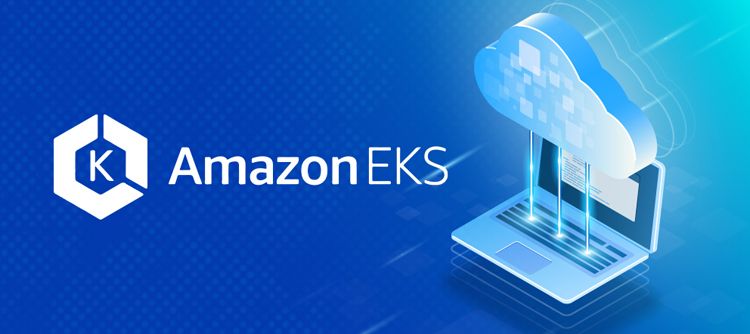
Subscribe to our Blog
We're committed to your privacy. SayOne uses the information you provide to us to contact you about our relevant content, products, and services. check out our privacy policy.

Renjith RajAugust 26, 20227 min read

Generating table of contents...
Amazon EKS (Elastic Kubernetes Service) is a fully managed, cloud-based service that helps to build, secure, and maintain Kubernetes clusters with AWS.
It automates functions such as patching, node provisioning, and installing updates. The service allows node management functions for admins, as this allows for greater access control. EKS helps to automatically manage both the availability and scalability of a Kubernetes API server and the etcd persistence layer.
AWS handles every management task for the Kubernetes control plane including all the security configurations, patches, and upgrades. Because it is an Amazon service, EKS integrates with other functions such as Elastic Load Balancing, AWS CloudTrail, AWS Identity and Access Management, and Amazon Virtual Private Cloud.
Download Ebook for FREE "How to choose the best microservices vendor and trim the cost".
Admins can also move pods to non-AWS environments without any application code changes in addition to using Amazon services, because EKS uses several open-source tools, such as Kubernetes and Docker.
The cost of using Amazon EKS is $0.10/hour/cluster. Pricing varies if teams are also using Amazon EC2, as you are already paying for the AWS resources required to run Kubernetes worker nodes.
Kubernetes works on master-slave design architecture. The master is also called the control plane. If the master fails, it brings the entire cluster down. Therefore, it is vital to ensure the high availability of the master, this one being a single point of failure. Thus, ensuring the high availability of the master and simultaneously managing all the worker nodes is a cumbersome task.
Therefore, for most organizations, it is desirable to have managed Kubernetes clusters. This allows the concerned personnel to focus on the most important task at hand, which is running the applications.
Read our blog “How Kubernetes Works to Support Microservices Architecture”.
Google Cloud and Azure already have their managed Kubernetes services, GKE and AKS, respectively. With the release of EKS, Amazon has also rolled out its managed Kubernetes service that provides a seamless way to run and manage Kubernetes workloads.
As EKS runs on AWS, instead of creating Kubernetes-specific features from scratch, Amazon has reused/plugged in some of the existing AWS services along with EKS for achieving Kubernetes-specific functionalities. Given below is a brief overview.
Amazon EKS integrates IAM authentication with Kubernetes RBAC (role-based access control system which is native to Kubernetes) with the help of the Heptio Authenticator, a tool that uses AWS IAM credentials to authenticate a Kubernetes cluster. Here, it is possible to directly attach an RBAC role with an IAM entity, thus saving the pain of managing yet another set of credentials at cluster levels.
AWS has developed an open-source CNI plugin and it takes advantage of the fact that more than one network interface can be attached to a single EC2 instance. These interfaces are allowed to have multiple secondary private IPs associated with them, which are used to provide pods running on EKS having real IP addresses from the VPC CIDR pool. This improves the latency for inter-pod communications for the traffic flows without any overlay.
Any of the AWS ELB offerings (classic/network/application) can be used to route traffic to a service running on the working nodes.
The number of worker nodes in the cluster can shrink or grow by using the EC2 auto-scaling service.
Using the AWS route53 and External DNS project, it is possible to manage the DNS entries for the load balancers created when we create an ingress object in our EKS cluster or when a LoadBalancer type of service is created in the cluster. This helps to keep the DNS names in sync with the load balancers always and there is no need to pay separate attention to the same.
The responsibilities of an EKS cluster are shared between AWS and the customer. Whereas AWS takes care of the most critical part of managing the control plane (API server, etcd database), the customers have to manage the worker nodes. Amazon EKS is designed to automatically run Kubernetes with three masters across three different Availability Zones to protect against a single point of failure. The control plane nodes are also monitored constantly and replaced in case they fail. The nodes are patched and updated automatically and this ensures the high availability of the cluster. All of these make it very simple to migrate existing workloads to EKS.
Kubernetes allows the scalability to adjust to sudden traffic changes seamlessly. Container workflow is both automated and simplified, as Kubernetes works to take care of container orchestration and the workflow for all the containers—including storage, logs, and networking—every day.
Kubernetes supports your business goals better when running on Amazon Elastic Kubernetes Service (EKS). Running on Amazon EKS enables Kubernetes helps to support business goals and also provides benefits in terms of deploying, managing, and scaling containerized applications. EKS offers a large amount and allows you to run containers optimally on Amazon Web Services (AWS).
Do you want to overcome business bottlenecks by implementing microservices? Talk to us today!
Running Kubernetes on Amazon EKS makes it easier to work with existing container infrastructure or migrations. Customizable container or node management is possible and allows greater granular control. This helps you to leverage the broader Kubernetes ecosystem more efficiently. Migration can help you to expand availability while maximizing cost benefits and enhancing the overall value of your Kubernetes investment.
Amazon EKS is a fully managed service, and you can have all of Kubernetes’ advantages without having to appoint an in-house expert to maintain infrastructure. Administrators can focus on their clusters and workloads as EKS automates load distribution and parallel processing faster and more efficiently.
With Amazon EKS there arises no need to install, operate, or maintain your Kubernetes control plane.
Moreover, any application running on Amazon EKS is compatible with others running on your existing Kubernetes environment and this means that you can migrate to EKS without any code changes!
EKS ensures full-time availability by running Kubernetes with three masters on three AWS availability zones. Thus it provides the optimal Kubernetes deployment, maintenance, scaling, and monitoring for the Cloud.
Whatever the strategy for migration into EKS, it has to properly fit into the organizational needs. Only then will it be a success.
At SayOne, we offer independent and stable services that have separate development aspects as well as maintenance advantages. We build microservices especially suited for individuals' businesses in different industry verticals. In the longer term, this would allow your organization/business to enjoy a sizeable increase in both growth and efficiency. We create microservices as APIs with security and the application built in. We provide SDKs that allow for the automatic creation of microservices.
Our comprehensive services in microservices development for start-ups, SMBs, and enterprises start with extensive microservices feasibility analysis to provide our clients with the best services. We use powerful frameworks for our custom-built microservices for different organizations. Our APIs are designed to enable fast iteration, easy deployment, and significantly less time to market. In short, our microservices are dexterous and resilient and deliver the security and reliability required for the different functions.

We're committed to your privacy. SayOne uses the information you provide to us to contact you about our relevant content, products, and services. check out our privacy policy.

About Author
Chief Technology Officer @ SayOne Technologies | Conversational AI, LLM

We collaborate with visionary leaders on projects that focus on quality